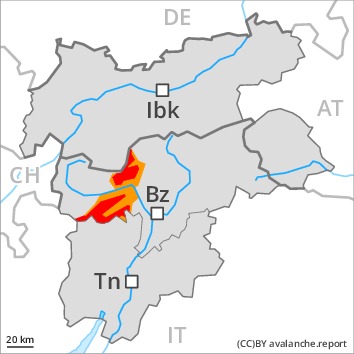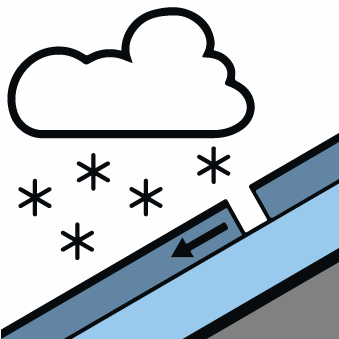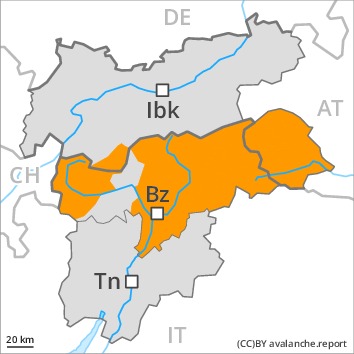
Danger level
 | 2200m
|
Avalanche Problem
 | | New snow |
|  | |  |
 | | Gliding snow |
|  | |  |
 | | Persistent weak layer |
|  | |  |

At elevated altitudes a critical avalanche situation will be encountered in some regions.
High altitudes and the high Alpine regions: The large quantity of fresh snow and in particular the sometimes deep wind slabs can be released easily, or, in isolated cases naturally in all aspects. The number and size of avalanche prone locations will increase with altitude. On steep sunny slopes individual loose snow avalanches are possible. Avalanches can also penetrate deep layers and reach large size.
Low and intermediate altitudes: As the snowfall level drops there will be a gradual decrease in the danger of moist and wet avalanches during the night. A substantial danger of gliding avalanches exists. Areas with glide cracks are to be avoided as far as possible.
Extensive experience in the assessment of avalanche danger is required.
Snowpack
dp.6: cold, loose snow and wind
dp.2: gliding snow
10 to 20 cm of snow, and even more in some localities, will fall above approximately 1500 m. 20 to 40 cm of snow has fallen thus far above approximately 1800 m. As a consequence of new snow and a sometimes strong southerly wind, avalanche prone wind slabs formed on Sunday in particular in gullies and bowls and behind abrupt changes in the terrain. The snowpack is moist, in particular at low and intermediate altitudes.
Avalanche prone weak layers exist in the centre of the snowpack in all aspects, in particular above approximately 1900 m.
Tendency
Fresh wind slabs require caution. In addition a latent danger of gliding avalanches exists.

Danger level
 | 2200m
|
Avalanche Problem
 | | Wind-drifted snow |
|  | |  |
 | | Gliding snow |
|  | |  |
 | | Persistent weak layer |
|  | |  |

A critical avalanche situation will persist in some cases.
High altitudes and the high Alpine regions: The fresh snow and in particular the sometimes deep wind slabs can be released easily, or, in isolated cases naturally in all aspects. The number and size of avalanche prone locations will increase with altitude. On steep sunny slopes individual loose snow avalanches are possible. Avalanches can also penetrate deep layers and reach dangerously large size.
Low and intermediate altitudes: As the snowfall level drops there will be a gradual decrease in the danger of moist and wet avalanches during the night. A substantial danger of gliding avalanches exists. Areas with glide cracks are to be avoided as far as possible.
In the regions exposed to heavier precipitation the avalanche prone locations are more prevalent and larger. Extensive experience in the assessment of avalanche danger is required.
Snowpack
dp.6: cold, loose snow and wind
dp.2: gliding snow
In some regions up to 15 cm of snow, and even more in some localities, will fall above approximately 1500 m. 10 to 30 cm of snow has fallen thus far above approximately 1800 m. As a consequence of new snow and a sometimes strong southerly wind, avalanche prone wind slabs formed on Sunday in particular in gullies and bowls and behind abrupt changes in the terrain. The snowpack is moist, in particular at low and intermediate altitudes.
Avalanche prone weak layers exist in the centre of the snowpack in all aspects, in particular above approximately 1900 m.
Tendency
Fresh wind slabs require caution. In addition a latent danger of gliding avalanches exists.














